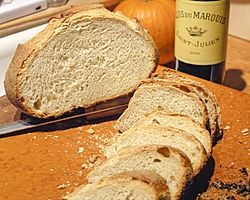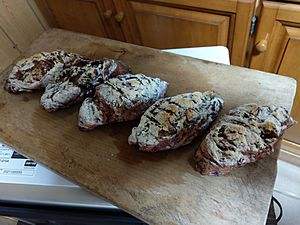Pain de campagne facts for kids
 |
|
| Type | Bread |
|---|---|
| Place of origin | France |
Pain de campagne means "country bread" in French. It is also known as "French sourdough." This bread is usually a large, round loaf. It gets its rise from either natural leavening (wild yeast) or baker's yeast. Most traditional versions use a mix of white flour, whole wheat flour, and sometimes rye flour. Water, leavening, and salt are also key ingredients.
Contents
A Taste of History
For hundreds of years, French villages had shared ovens. People would bring their bread dough to these ovens to be baked. The loaves were very big, weighing from about 1.5 to 5.5 kilograms (4 to 12 pounds). These large loaves could feed a family for many days, sometimes even weeks. They lasted until the next baking day.
Before modern milling, wheat was ground using large stones. To make lighter bread, the whole wheat flour was sifted. This removed some of the bran and germ. The result was a whiter flour, but it still had some healthy parts of the grain.
Rye flour was sometimes added to recipes. This was because rye often grew mixed in with the wheat. If up to 10 percent of the harvest was rye, it would all be ground together. Rye flour ferments faster than wheat flour. It also gives traditional pains de campagne a special flavor.
The Rise and Return of Country Bread
Around the early 1900s, commercial yeast became popular. Because of this, pain de campagne became less common in French cities. It was replaced by the baguette, a long, thin loaf.
However, in the 1970s, artisan breads started to become popular again. Artisan breads are made using traditional methods. Since then, pain de campagne has been growing in popularity. People in Europe and the United States now enjoy it more and more.
How Pain de Campagne is Made Today
Today, pain de campagne is still made in France. It is also very popular in the United States and the UK. When made in the traditional way, the dough ferments for several hours. This allows the yeasts to grow and create rich flavors.
After fermenting, the dough is shaped into a round. It is then placed in special linen-lined baskets called "bannetons." These baskets help the dough keep its shape as it rises. Once the dough has risen enough, it is carefully turned out of the basket. It is then slid into a hot oven. The bread bakes at about 240 °C (450 °F) for around one hour.
See also
 In Spanish: Pain de campagne para niños
In Spanish: Pain de campagne para niños


